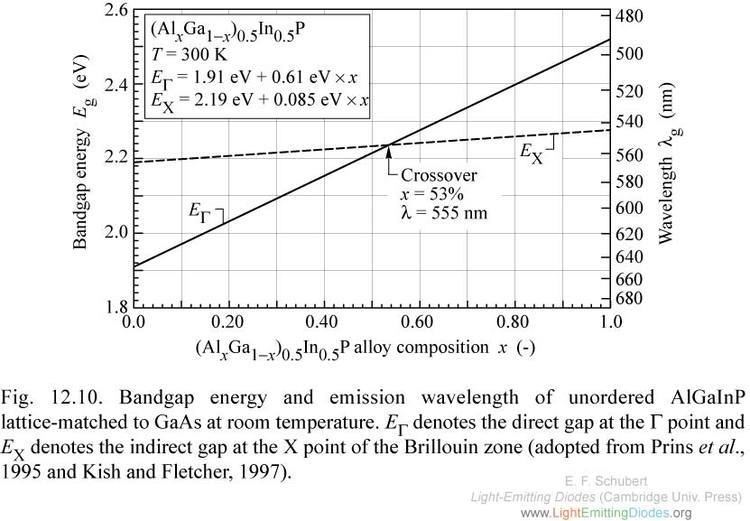 | ||
How to say aluminium gallium indium phosphides in german
Aluminium gallium indium phosphide (AlGaInP, also AlInGaP, InGaAlP, etc.) is a semiconductor material that provides a platform for the development of novel multi-junction photovoltaics and optoelectronic devices, as it spans a direct bandgap from deep ultraviolet to infrared.
Contents
- How to say aluminium gallium indium phosphides in german
- Formation
- Properties
- Zinc blende structure
- Applications
- AlGaInP laser
- LED
- Safety and toxicity aspects
- References
AlGaInP is used in manufacture of light-emitting diodes of high-brightness red, orange, green, and yellow color, to form the heterostructure emitting light. It is also used to make diode lasers.
Formation
AlGaInP layer is often grown by heteroepitaxy on gallium arsenide or gallium phosphide in order to form a quantum well structure.
Heteroepitaxy is a kind of epitaxy performed with materials that are different from each other. In heteroepitaxy, a crystalline film grows on a crystalline substrate or film of a different material.
This technology is often used to grow crystalline films of materials for which single crystals cannot 1D View
Another example of heteroepitaxy is gallium nitride (GaN) on sapphire
Properties
AlGaInP is a semiconductor, which means that its valence band is completely full. The eV of the band gap between the valence band and the conduction band is small enough that it is able to emit visible light (1.7eV - 3.1eV). The band gap of AlGaInP is between 1.81eV and 2eV. This corresponds to Red, orange, or yellow light, and that is why the LED's made from AlGaInP are those colors.
Zinc blende structure
AlGaInP's structure is categorized within a specific unit cell called the Zinc blende Structure. Zinc blende/sphalerite is based on a FCC lattice of anions. It has 4 asymmetric units in its unit cell. It is best thought of as a face-centered cubic array of anions and cations occupying one half of the tetrahedral holes. Each ion is 4-coordinate and has local tetrahedral geometry. Zinc blende is its own antitype—you can switch the anion and cation positions in the cell and it doesn't matter (as in NaCl). In fact, replacement of both the Zn and S with C gives the diamond structure!
Applications
AlGaInP can be applied to:
AlGaInP laser
The aluminium gallium indium phosphide laser is a type of visible-light diode laser. Visible diode lasers emit wavelengths of red and green in the visible spectrum of electromagnetic radiation. The diode lasers consist of a semiconductor material in which the p-n junction forms the active medium. The AlGaInP laser emits wavelengths of 0.63-0.9 µm. Each of these wavelengths is used for different applications. Some of the other applications of the AlGaInP laser are listed below:
The primary application AlGaInP laser is in optical disc readers, DVD players and compact disc players Other uses include laser pointers, gas sensors, as a pumping source and for machining.
LED
AlGaInP can be used as an LED. An LED is composed of a p-n junction which contain a p-type and an n-type. In this p-n junction, the p-type is AlGaIn, and the n-type is P. The material used in the semiconducting element of an LED determines its color.
AlGaInP is one of the two main types of LEDs presently used for lighting systems. The other is indium gallium nitride (InGaN)
Slight changes in the composition of these alloys changes the color of the emitted light.
AlGaInP alloys for red, orange and yellow LEDs
InGaN alloys for green, blue and white LEDs
Safety and toxicity aspects
The toxicology of AlGaInP has not been fully investigated. The dust is an irritant to skin, eyes and lungs. The environment, health and safety aspects of aluminium indium gallium phosphide sources (such as trimethylgallium, trimethylindium and phosphine) and industrial hygiene monitoring studies of standard MOVPE sources have been reported recently in a review. Illumination by a AlGaInP laser was associated in one study with slower healing of skin wounds in laboratory rats.
